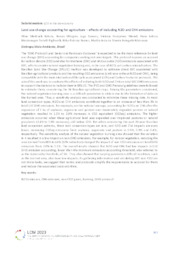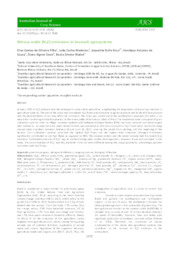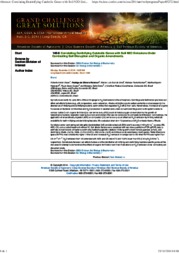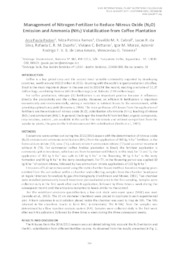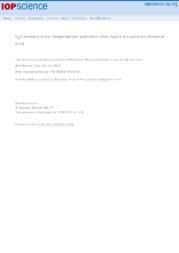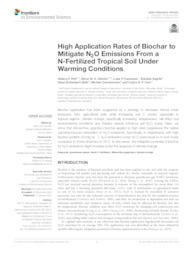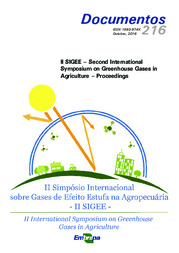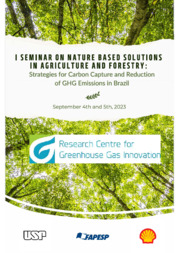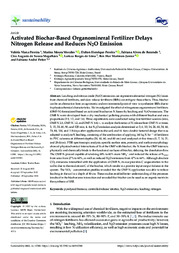Search Publications
Filter by:
| Author(s): BATISTA, A. M.; NOVAES, R. M. L.; MACIEN, V. G.; PIGHINELLI, A. L. M. T.; RAMOS, N. P.; MATSUURA, M. I. da S. F. The GHG Protocol Land Sector and Removals Guidance is expected to be the main reference for land use change (LUC) accounting for companies seeking net-zero targets. This protocol requires an account f... ... |
| Author(s): OLIVEIRA FILHO, E. G. de; MEDEIROS, J. C.; ROSA, J. D.; SOUZA, H. A. de; DEON, D. S.; MADARI, B. E. In Brazil, 87% of N2O released into the atmosphere comes from agriculture, emphasizing the importance of assessing emissions in agricultural systems. The aim of this study was to evaluate N2O fluxes a... ... |
| Author(s): GRAVE, R. A.; NICOLOSO, R. da S.; SILVA, M. L. B. da; MEZZARI, M. P.; HIGARASHI, M. M.; CASSOL, P. C.; COSTA, M. D.
|
| Author(s): PACKER, A. P.; RAMOS, N. P.; CABRAL, O. M. R.; SILVA, L. R. da; MOLTOCARO, R. C. R.; BETTANIN, V. C.; MORASI, I. M.; AMARO, A. R. F. V. B. de L.; TEIXEIRA, W. G. Coffee is a key global crop and the second most valuable commodity exported by developing countries, worth around US$19 billion in 2015. Counting with the world\s largest production of coffee, Brazil... ... |
| Author(s): DEON, D. S.; CERRI, C. E. P.; CONANT, R. Among the main greenhouse gases (CO2, CH4 and N2O), N2O has the highest global warming potential. N2O emission is mainly connected to agricultural activities, increasing as nitrogen concentrations inc... ... |
| |
| Author(s): RITTL, T. F.; OLIVEIRA, D. M. S.; CANISARES, L. P.; SAGRILO, E.; BUTTERBACH-BAHL, K.; DANNENMANN, M.; CERRI, C. E. P. Biochar application has been suggested as a strategy to decrease nitrous oxide emissions from agricultural soils while increasing soil C stocks, especially in tropical regions. Climate change, specifi... ... |
| Ratio of nitrous oxide (N2O) emission from soil to forage productivity in the Amazon of Mato Grosso. Author(s): OLIVEIRA, C. M.; NASCIMENTO, A. F. do; PEDREIRA, B. C. e; PEREIRA, D. H.; DEVENS, J.; RODRIGUES, R. de A. R. Fertilizers used as sources of nitrogen (N) are essential to increase the forage production (Costa et al., 2009), however, they lead to a higher N2O emission from soil (Gagnon et al., 2011). Nowadays,... ... |
| Author(s): PENTEADO, L. F.; NOGUEIRA, S. F.; ANDRADE, C. A. de; RAMOS, N. P.; PAZIANOTTO, R. A. A.; GAROFALO, D. T. Between 1985 and 2020, Brazil increased its pasture area by 38%, from 111 to 154 million hectares. In turn, N2O emissions from the agriculturallivestock sector in 2016 accounted for 87% of the total e... ... |
| Author(s): PEREIRA, V. V.; MORALES, M. M.; PEREIRA, D. H.; REZENDE, F. A. de; MAGALHÃES, C. A. de S.; LIMA, L. B. de; MARIMON-JUNIOR, B. H.; PETTER, F. A. Leaching and nitrous oxide (N2O) emissions can represent substantial nitrogen (N) losses from chemical fertilizers, and slow-release fertilizers (SRFs) can mitigate these effects. Thus, biochar can be... ... |
Observation
Some of Embrapa's publications are published as ePub files. To read them, use or download one of the following free software options to your computer or mobile device. Android: Google Play Books; IOS: iBooks; Windows and Linux: Calibre.
Access other publications
Access the Agricultural Research Database (BDPA) to consult Embrapa's full library collection and records.
Visit Embrapa Bookstore to purchase books and other publications sold by Embrapa.

